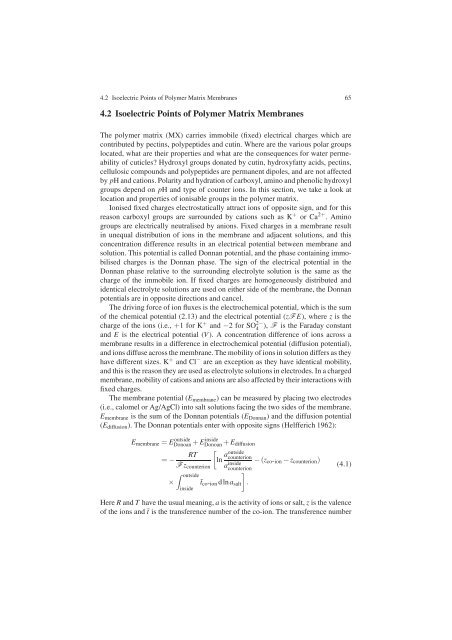Water and Solute Permeability of Plant Cuticles: Measurement and ...
Water and Solute Permeability of Plant Cuticles: Measurement and ...
Water and Solute Permeability of Plant Cuticles: Measurement and ...
You also want an ePaper? Increase the reach of your titles
YUMPU automatically turns print PDFs into web optimized ePapers that Google loves.
4.2 Isoelectric Points <strong>of</strong> Polymer Matrix Membranes 65<br />
4.2 Isoelectric Points <strong>of</strong> Polymer Matrix Membranes<br />
The polymer matrix (MX) carries immobile (fixed) electrical charges which are<br />
contributed by pectins, polypeptides <strong>and</strong> cutin. Where are the various polar groups<br />
located, what are their properties <strong>and</strong> what are the consequences for water permeability<br />
<strong>of</strong> cuticles? Hydroxyl groups donated by cutin, hydroxyfatty acids, pectins,<br />
cellulosic compounds <strong>and</strong> polypeptides are permanent dipoles, <strong>and</strong> are not affected<br />
by pH <strong>and</strong> cations. Polarity <strong>and</strong> hydration <strong>of</strong> carboxyl, amino <strong>and</strong> phenolic hydroxyl<br />
groups depend on pH <strong>and</strong> type <strong>of</strong> counter ions. In this section, we take a look at<br />
location <strong>and</strong> properties <strong>of</strong> ionisable groups in the polymer matrix.<br />
Ionised fixed charges electrostatically attract ions <strong>of</strong> opposite sign, <strong>and</strong> for this<br />
reason carboxyl groups are surrounded by cations such as K + or Ca 2+ . Amino<br />
groups are electrically neutralised by anions. Fixed charges in a membrane result<br />
in unequal distribution <strong>of</strong> ions in the membrane <strong>and</strong> adjacent solutions, <strong>and</strong> this<br />
concentration difference results in an electrical potential between membrane <strong>and</strong><br />
solution. This potential is called Donnan potential, <strong>and</strong> the phase containing immobilised<br />
charges is the Donnan phase. The sign <strong>of</strong> the electrical potential in the<br />
Donnan phase relative to the surrounding electrolyte solution is the same as the<br />
charge <strong>of</strong> the immobile ion. If fixed charges are homogeneously distributed <strong>and</strong><br />
identical electrolyte solutions are used on either side <strong>of</strong> the membrane, the Donnan<br />
potentials are in opposite directions <strong>and</strong> cancel.<br />
The driving force <strong>of</strong> ion fluxes is the electrochemical potential, which is the sum<br />
<strong>of</strong> the chemical potential (2.13) <strong>and</strong> the electrical potential (zF E), where z is the<br />
charge <strong>of</strong> the ions (i.e., +1 for K + <strong>and</strong> −2 for SO2−), F is the Faraday constant<br />
4<br />
<strong>and</strong> E is the electrical potential (V). A concentration difference <strong>of</strong> ions across a<br />
membrane results in a difference in electrochemical potential (diffusion potential),<br />
<strong>and</strong> ions diffuse across the membrane. The mobility <strong>of</strong> ions in solution differs as they<br />
have different sizes. K + <strong>and</strong> Cl− are an exception as they have identical mobility,<br />
<strong>and</strong> this is the reason they are used as electrolyte solutions in electrodes. In a charged<br />
membrane, mobility <strong>of</strong> cations <strong>and</strong> anions are also affected by their interactions with<br />
fixed charges.<br />
The membrane potential (Emembrane) can be measured by placing two electrodes<br />
(i.e., calomel or Ag/AgCl) into salt solutions facing the two sides <strong>of</strong> the membrane.<br />
Emembrane is the sum <strong>of</strong> the Donnan potentials (EDonnan) <strong>and</strong> the diffusion potential<br />
(Ediffusion). The Donnan potentials enter with opposite signs (Helfferich 1962):<br />
Emembrane = E outside<br />
Donoan<br />
= −<br />
×<br />
+ Einside Donoan + Ediffusion<br />
RT<br />
�<br />
ln aoutside<br />
counterion<br />
F zcounterion ainside −(zco-ion − zcounterion)<br />
counterion<br />
� �<br />
outside<br />
¯tco-ion dlnasalt .<br />
inside<br />
(4.1)<br />
Here R <strong>and</strong> T have the usual meaning, a is the activity <strong>of</strong> ions or salt, z is the valence<br />
<strong>of</strong> the ions <strong>and</strong> ¯t is the transference number <strong>of</strong> the co-ion. The transference number







